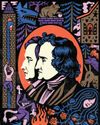
Nine months into the pandemic, Nick Thompson, a marketer at a tech firm in Chicago, got a message on LinkedIn inviting him to apply to be a contestant on a Netflix reality show called “Love Is Blind.” Thompson, a Midwesterner with bright-blue eyes and a sheepish smile, didn’t watch much reality TV, although he’d caught a bit of “The Bachelor” so that he could join a betting bracket at his office. He was more of a fan of W.W.E. wrestling, so much so that he’d once trained to become a wrestler himself. “For, like, a day,” he said, laughing—he’d busted his ankle, then quit.
The format of “Love Is Blind” sounded outlandish: fifteen men and fifteen women were gathered in Los Angeles, where they were ensconced in individual “pods” and flirted with strangers through a wall. After just a few days of speed courtship, contestants fell in love and, amazingly, some got engaged, sight unseen. The show’s producers, who worked for a company called Kinetic Content, emphasized that “Love Is Blind,” despite its premise, wasn’t some sleazy guilty pleasure like “Temptation Island.” It was a sincere experiment in human intimacy—participants were placed on a “digital fast” designed to liberate them from all distractions, including physical appearance, so that they could form a deeper, more lasting bond with a partner. The producers weren’t looking for clout-chasers but for emotionally mature adults, people who were ready to commit to marriage, for real.
Denne historien er fra May 27, 2024-utgaven av The New Yorker.
Start din 7-dagers gratis prøveperiode på Magzter GOLD for å få tilgang til tusenvis av utvalgte premiumhistorier og 9000+ magasiner og aviser.
Allerede abonnent ? Logg på
Denne historien er fra May 27, 2024-utgaven av The New Yorker.
Start din 7-dagers gratis prøveperiode på Magzter GOLD for å få tilgang til tusenvis av utvalgte premiumhistorier og 9000+ magasiner og aviser.
Allerede abonnent? Logg på

LIFE ADVICE WITH ANIMAL ANALOGIES
Go with the flow like a dead fish.

CONNOISSEUR OF CHAOS
The masterly musical as mblages of Charles Ives

BEAUTIFUL DREAMERS
How the Brothers Grimm sought to awaken a nation.

THE ARTIFICIAL STATE
A different kind of machine politics.

THE HONEST ISLAND GREG JACKSON
Craint did not know when he had come to the island or why he had come.

THE SHIPWRECK DETECTIVE
Nigel Pickford has spent a lifetime searching for sunken treasure-without leaving dry land.

THE HOME FRONT
Some Americans are preparing for a second civil war.

PRESIDENT FOR SALE
On a mid-October Sunday not long ago sun high, wind cool-I was in Harrisburg, Pennsylvania, for a book festival, and I took a stroll.

SYRIA'S EMPIRE OF SPEED
Bashar al-Assad's regime is now a narco-state reliant on sales of amphetamines.

TUCKER EVERLASTING
Trump's favorite pundit takes his show on the road.